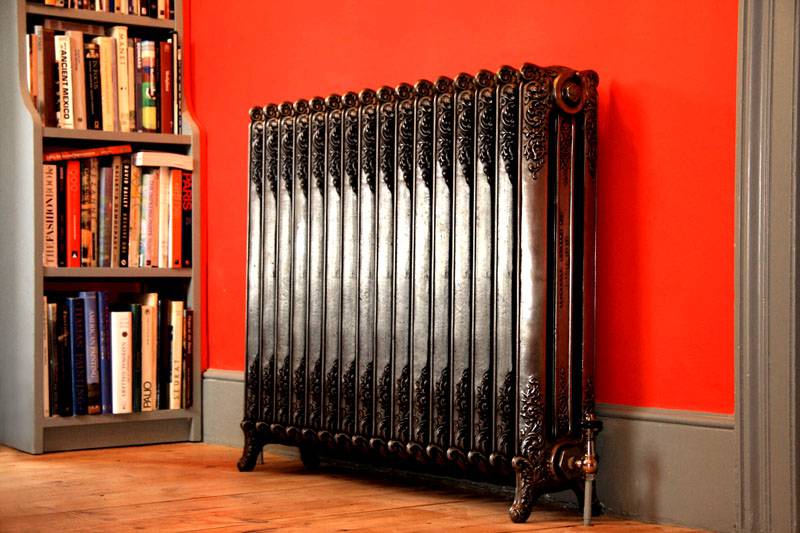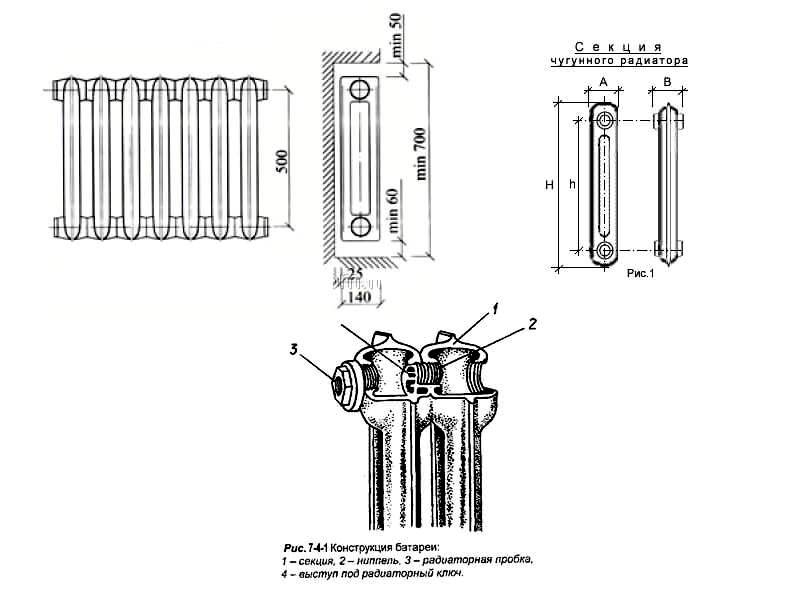Which heating radiators are best for an apartment: the secrets of choosing
The long-term operation of the entire system and its efficiency completely depend on the correct selection of batteries. Increased requirements are imposed on such equipment, especially when used in an apartment. In multi-apartment buildings, heating is most often tied to a centralized scheme, which increases the risk of water hammer. Which heating radiators are best for an apartment will be prompted by an analysis of individual models and characteristics of equipment.

When deciding which heating radiators are best installed in an apartment, you need to learn more about the capabilities of the heating system in multi-apartment buildings. At the same time, there is no need to equip a gas boiler and monitor the operation of the equipment, controlling the entire process. The coolant moves from one device to another, giving off heat through the surface of the radiator.

This system has various problems. The water in the batteries often changes temperature, and there are also pressure drops. A water hammer with a battery breakthrough is especially dangerous.
When selecting heating devices, you should pay attention to the following criteria:
- material of manufacture;
- the ability of the material to withstand a pressure of about 12-15 atmospheres;
- the material must be distinguished by safety and resistance to a sharp pressure head and its drops;
- the product should not undergo corrosion and various damage;
- an important indicator of a product is the heat transfer of equipment;
- operational period;
- product appearance.

When choosing radiators, it is worth considering the operating and test pressure.
Useful advice! You should not pay more money for the safety margin of pressure indicators, since the shut-off valves will not withstand a pressure of more than 15 kg / cm2.
Related article:
In the article, we will consider in detail the design, modern modifications, application features, parameters of devices for a radiator, an overview of modern models and the secrets of correct installation of the regulator on your own without errors.
Types of heating batteries in the apartment and their characteristics
Many people wonder how to choose heating radiators for an apartment. In this case, the characteristics of a particular material are important.
| Varieties of radiators | Specifications |
| Cast iron | Pressure value from 10 to 13 bar. The power indicator of the section is up to 160 watts. A temperature indicator is allowed - 150 degrees. |
| Aluminum | Pressure from 7 to 17 bar. The maximum value of the water temperature in the battery is 110. |
| Steel | Pressure from 6 to 15 bar. High heat transfer rate. Corrosion protection. |
| Bimetallic | Provided for pressure up to 50 atmospheres and temperatures up to 130 degrees. |

Features of cast iron radiators
Cast iron radiators were especially popular in Soviet times. Such designs have certain advantages:
- long service life;
- corrosion resistance;
- affordable cost;
- maintaining the temperature when the system is turned off.

Also, such structures are resistant to various types of heat transfer fluids, ease of installation and resistance to various chemical compounds.
The disadvantages include the fact that such products heat up for a long time, are characterized by heavy weight and do not have protection against water hammer. The choice of cast-iron types of heating radiators for an apartment is just as good as the choice of such an option for industrial buildings, suburban dwellings and cottages.

Steel models
Steel products do not have sections, but are made as a set. They can withstand temperatures up to 120 degrees. It is believed that it is better to install them in buildings with an autonomous heating circuit or in small buildings. You cannot use such elements in rooms with high levels of humidity: in bathrooms or saunas. The steel unit must always be filled with water to protect it from rust.

Deciding which heating radiators are best for an apartment and choosing this option, you can get certain advantages. Such a device warms up quickly, is characterized by increased heat transfer and has a presentable design.

Steel options are tubular and panel. The latest designs have the following positive properties:
- excellent heat dissipation;
- environmentally friendly safety;
- low cost;
- high level of efficiency.
The disadvantages include susceptibility to corrosion, the inability to use in multi-storey buildings, and convection can provoke the appearance of drafts.
The tubular models have the following advantages:
- increased heat transfer rate;
- working pressure from 8 to 15 bar;
- protective properties against corrosion.
The main indicators for these two types of radiators differ little. Only tubular models are more expensive due to their higher values.

Aluminum products
Many are interested in how to choose a heating radiator made of aluminum. There are two types of such instructions. Cast - are made by casting and have wide walls. Extrusion - differ in the technology of extrusion of an aluminum alloy through an extruder. You cannot add sections to such a product.

The benefits include:
- increased degree of heat transfer;
- light weight and easy installation;
- the ability to warm up the room in a short time;
- profitability when using a thermostat.

The disadvantages include susceptibility to corrosion, fragility and a tendency to form leaks. In addition, such designs do not provide protection against water hammer. Similar designs are produced by representatives of different countries. These are the Chinese companies Konner and Lammin. Russian firm Rifar and equipment from Italy from the companies Global and Royal Thermo.
Note! It is important that the appliance has a polymer coating to extend the life of the product.
Which radiator is better than aluminum or bimetallic?
When deciding which heating radiator is best for an apartment - bimetallic or aluminum, you should find out their features.

A feature of an aluminum product is that it can only be purchased for private houses. Such equipment should not be installed in production where there are pressure surges. The aluminum radiator can be used in conjunction with a temperature controller. Exceeding the permissible pressure indicator is fraught with rupture of the battery and the appearance of internal corrosion.
Bimetallic models are able to serve for a long period of time, as they are resistant to pressure head up to 50 atmospheres. These structures consist of a steel filling and aluminum ribs. They warm up quickly and are characterized by an aesthetic appearance. The disadvantages include the accumulation of slag deposits inside the sections. In addition, due to the use of multiple material options, the heat transfer rate may be reduced.

Heating radiators: prices and model overview
Considering which heating battery is best for an apartment, it is recommended to read about models from different manufacturers. When making a purchase, you need to familiarize yourself with the certificate of conformity.
| Image | Model | Specifications | Cost, rub. |
 |
Rifar Base 500 | Sectional model. The material is aluminum. Area-1.9-28 sq.m. The number of sections can be up to 20. |
4400 |
 |
Kermi FKO 22 500 | Panel and wall model. The material is steel. Heating area up to 58 sq.m. Working pressure up to 10 bar. |
5050 |
 |
Royal Thermo BiLiner 500 | Bimetal and wall model. The number of sections is up to 14. Working pressure - 20 bar. |
6900 |
 |
Global STYLE PLUS 500 | Heating area - 19 sq.m. Number of sections -10. Bimetallic model. | 9300 |
 |
Sira RS Bimetal 500 | Number of sections up to 8. Sectional and bimetallic model. Working pressure up to 40 bar. | 6800 |
 |
Buderus Logatrend VK-Profil 22 500 | Heated area up to 19 sq. m. Working pressure - 10 bar. | 4900 |
 |
Purmo Compact 22 500 | Panel steel construction. Working pressure 10 bar. | 5300 |

Models of the following manufacturers are popular with domestic consumers:
- the Italian companies Syrah and Global produce equipment that is well adapted to Russian heating systems;
- models of the German company Kermi are distinguished by powerful convection and excellent quality;
- steel tubular radiators are manufactured by the Swedish company Zehnder. Such structures are coated with an anti-corrosion compound that protects the steel surface at any acidity;
- Rifar is a domestic manufacturer. Its products can be used in central heating systems;
- the products of the Chinese company Smart are of low cost;
- the German manufacturer Arbonia sells high-quality devices that are distinguished by modern design and durability.

How to calculate the power of radiators and the number of sections?
The acquisition of efficient, high-quality equipment should be complemented by correct calculations of the number of sections.
SNiP consists of design rules and operating standards for heating systems. Taking it into account, it is necessary to mount radiators. In order for the calculations to be effective, it is worth using the following rules:
- the maximum width of the structure should not exceed 70% of the size of the window opening;
- the product must be mounted along the center line of the window;
- the distance between the wall and the device is 3-5 cm;
- the product should rise no more than 12 cm above the floor;
- the distance from the battery to the windowsill is 5 cm.
In some cases, for better heat transfer, the wall surface is covered with a special reflective material. Such rules promote the free movement of air masses. For a correct calculation, you need to know the following parameters:
- the size of the rooms;
- the number and area of entrance doors and windows;
- materials for building a house;
- placement of rooms relative to the cardinal points;
- technical parameters of the heating structure.
The table shows a simple calculation of the number of sections.
| Power of 1 section of the heating radiator according to the passport, W | Room area, m2 | ||||||
| 10 | 12 | 14 | 16 | 18 | 20 | 22 | |
| 140 | 8 | 9 | 10 | 12 | 13 | 15 | 16 |
| 150 | 7 | 8 | 10 | 11 | 12 | 14 | 15 |
| 160 | 7 | 8 | 9 | 10 | 12 | 13 | 14 |
| 180 | 6 | 7 | 8 | 9 | 10 | 12 | 13 |
| 190 | 6 | 7 | 8 | 9 | 10 | 11 | 12 |
| 200 | 5 | 6 | 7 | 8 | 9 | 10 | 11 |
Article
